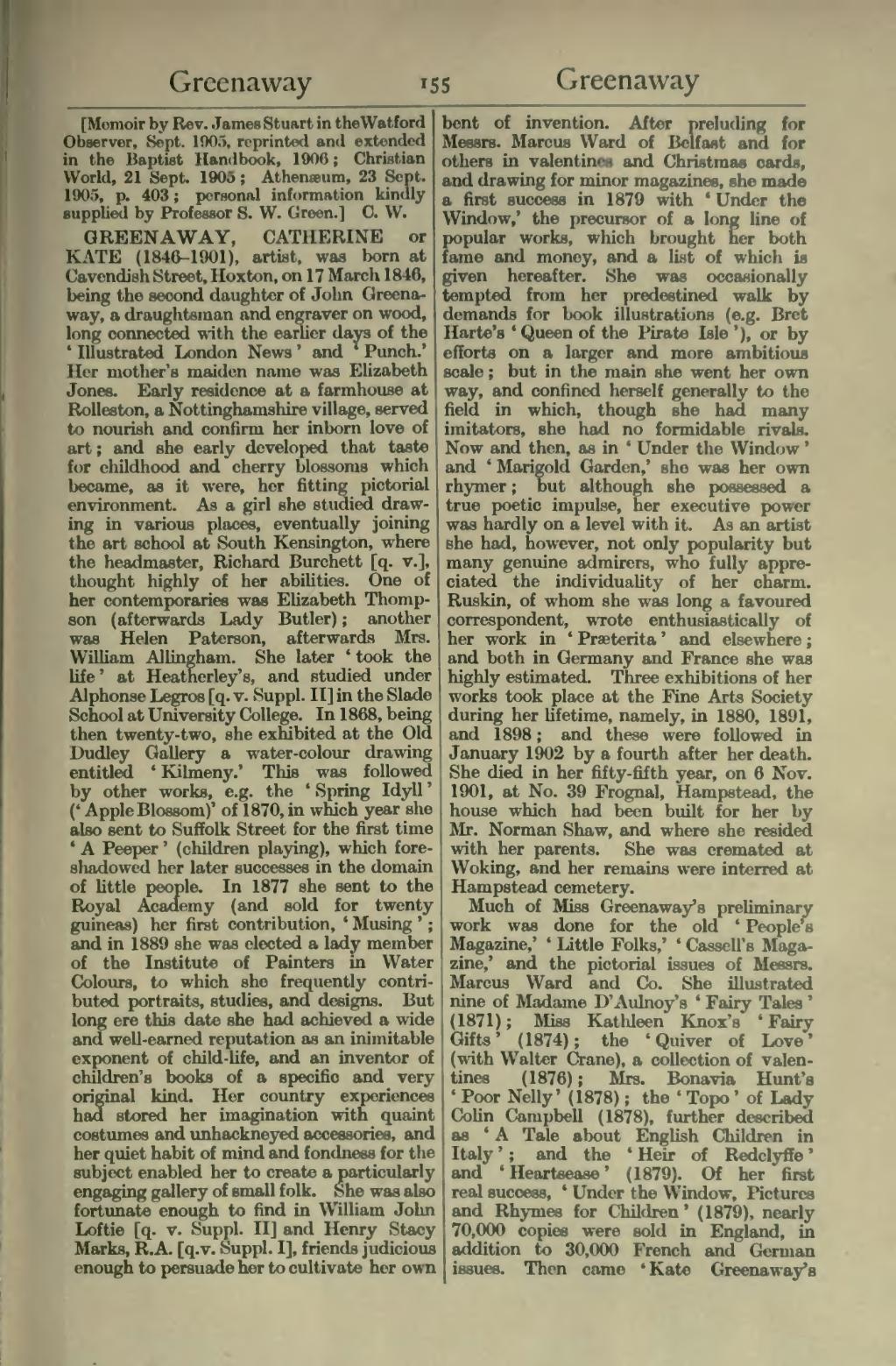[Memoir by Rev. James Stuart in the Watford Observer, Sept. 1905, reprinted and extended in the Baptist Handbook, 1906; Christian World, 21 Sept. 1905; Athenæum, 23 Sept. 1905, p. 403; personal information kindly supplied by Professor S. W. Green.]
GREENAWAY, CATHERINE or KATE (1846–1901), artist, was born at Cavendish Street, Hoxton, on 17 March 1846, being the second daughter of John Greenaway, a draughtsman and engraver on wood, long connected with the earlier days of the 'Illustrated London News' and 'Punch.' Her mother's maiden name was Elizabeth Jones. Early residence at a farmhouse at Rolleston, a Nottinghamshire village, served to nourish and confirm her inborn love of art; and she early developed that taste for childhood and cherry blossoms which became, as it were, her fitting pictorial environment. As a girl she studied drawing in various places, eventually joining the art school at South Kensington, where the headmaster, Richard Burchett [q. v.], thought highly of her abilities. One of her contemporaries was Elizabeth Thompson (afterwards Lady Butler); another was Helen Paterson, afterwards Mrs. William Allingham. She later 'took the life' at Heatherley's, and studied under Alphonse Legros [q. v. Suppl. II] in the Slade School at University College. In 1868, being then twenty-two, she exhibited at the Old Dudley Gallery a water-colour drawing entitled 'Kilmeny.' This was followed by other works, e.g. the 'Spring Idyll' ('Apple Blossom)' of 1870, in which year she also sent to Suffolk Street for the first time 'A Peeper' (children playing), which foreshadowed her later successes in the domain of little people. In 1877 she sent to the Royal Academy (and sold for twenty guineas) her first contribution, 'Musing'; and in 1889 she was elected a lady member of the Institute of Painters in Water Colours, to which she frequently contributed portraits, studies, and designs. But long ere this date she had achieved a wide and well-earned reputation as an inimitable exponent of child-life, and an inventor of children's books of a specific and very original kind. Her country experiences had stored her imagination with quaint costumes and unhackneyed accessories, and her quiet habit of mind and fondness for the subject enabled her to create a particularly engaging gallery of small folk. She was also fortunate enough to find in William John Loftie [q. v. Suppl. II] and Henry Stacy Marks, R.A. [q. v. Suppl. I], friends judicious enough to persuade her to cultivate her own bent of invention. After preluding for Messrs. Marcus Ward of Belfast and for others in valentines and Christmas cards, and drawing for minor magazines, she made a first success in 1879 with 'Under the Window,' the precursor of a long line of popular works, which brought her both fame and money, and a list of which is given hereafter. She was occasionally tempted from her predestined walk by demands for book illustrations (e.g. Bret Harte's 'Queen of the Pirate Isle'), or by efforts on a larger and more ambitious scale; but in the main she went her own way, and confined herself generally to the field in which, though she had many imitators, she had no formidable rivals. Now and then, as in 'Under the Window' and 'Marigold Garden,' she was her own rhymer; but although she possessed a true poetic impulse, her executive power was hardly on a level with it. As an artist she had, however, not only popularity but many genuine admirers, who fully appreciated the individuality of her charm. Ruskin, of whom she was long a favoured correspondent, wrote enthusiastically of her work in 'Præterita' and elsewhere; and both in Germany and France she was highly estimated. Three exhibitions of her works took place at the Fine Arts Society during her lifetime, namely, in 1880, 1891, and 1898; and these were followed in January 1902 by a fourth after her death. She died in her fifty-fifth year, on 6 Nov. 1901, at No. 39 Frognal, Hampstead, the house which had been built for her by Mr. Norman Shaw, and where she resided with her parents. She was cremated at Woking, and her remains were interred at Hampstead cemetery.
Much of Miss Greenaway's preliminary work was done for the old 'People's Magazine,' 'Little Folks,' 'Cassell's Magazine,' and the pictorial issues of Messrs. Marcus Ward and Co. She illustrated nine of Madame D'Aulney's 'Fairy Tales' (1871); Miss Katlileen Knox's 'Fairy Gifts' (1874); the 'Quiver of Love' (with Walter Crane), a collection of valentines (1876); Mrs. Bonavia Hunt's 'Poor Nelly' (1878); the 'Topo' of Lady Colin Campbell (1878), further described as 'A Tale about English Children in Italy'; and the 'Heir of Redclyffe' and 'Heartsease' (1879). Of her first real success, 'Under the Window, Pictures and Rhymes for Children' (1879), nearly 70,000 copies were sold in England, in addition to 30,000 French and German issues. Then came 'Kate Greenaway's
